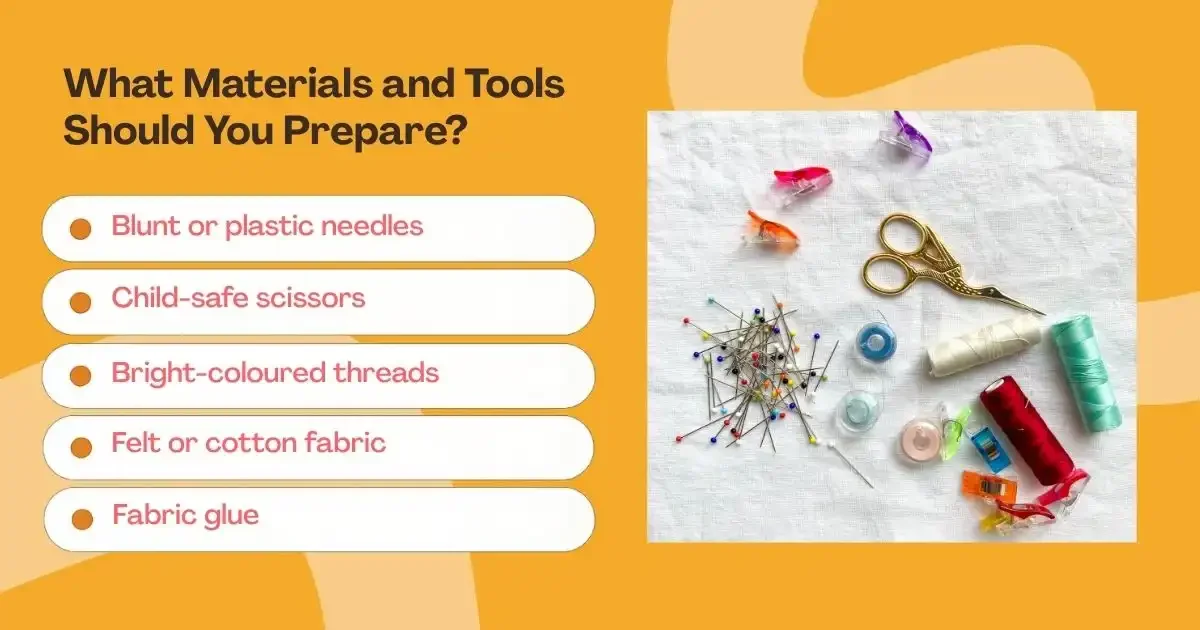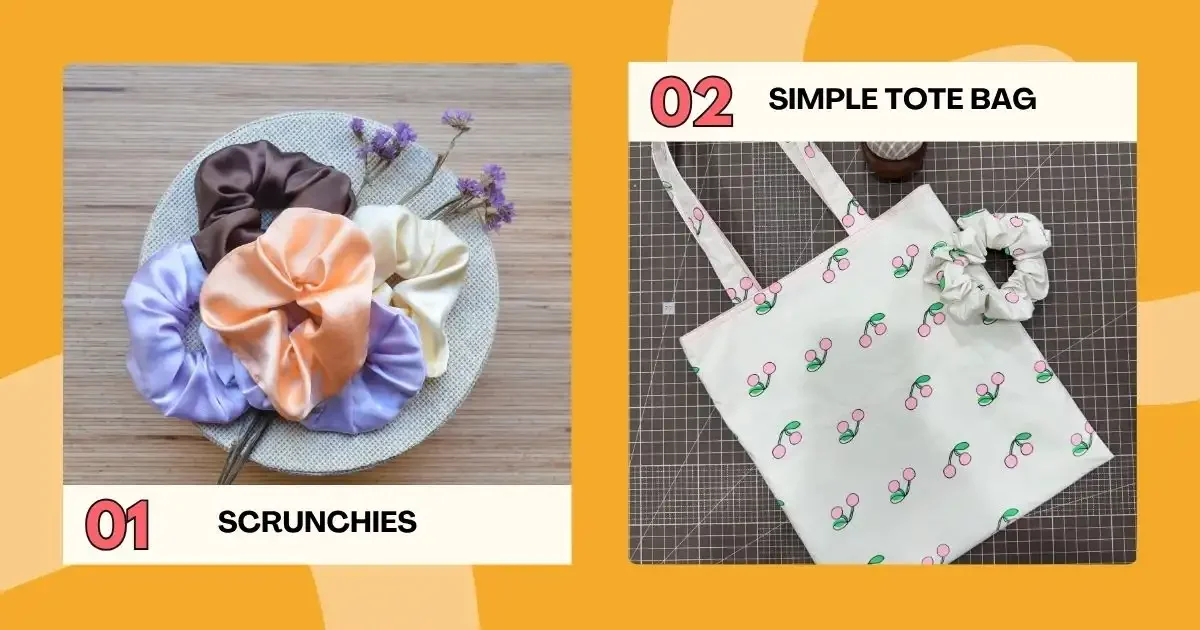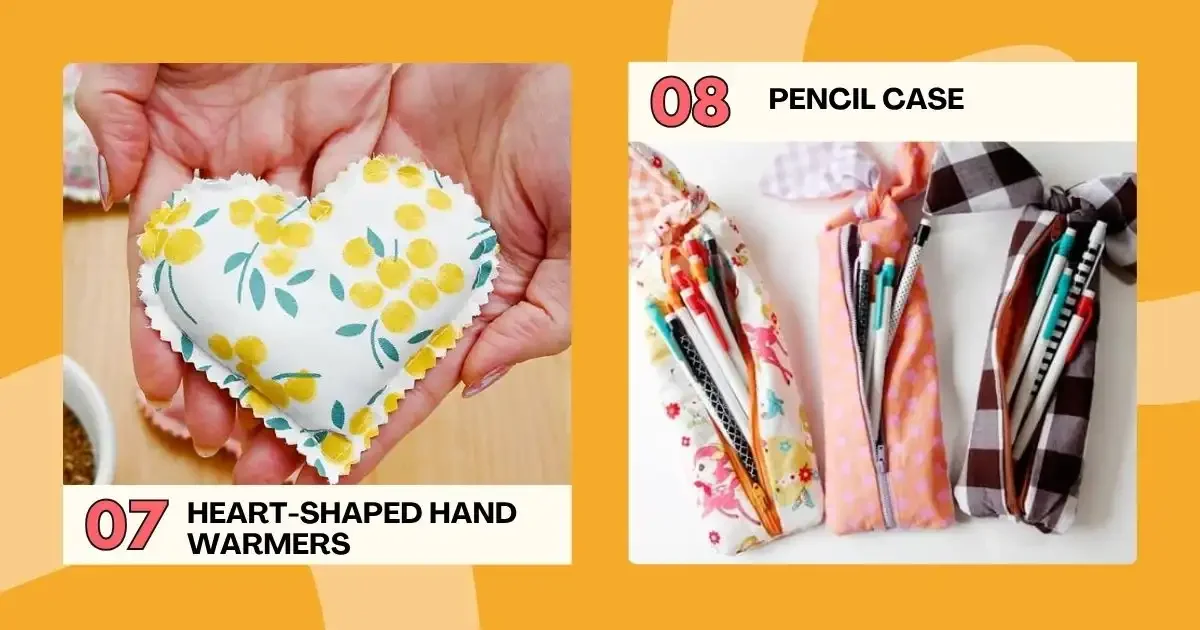Easy Sewing Projects for 10-Year-Olds
Easy sewing projects for 10-year-olds include scrunchies, felt bookmarks, mini tote bags, lavender sachets, and simple plush toys. These beginner-friendly crafts utilize safe tools, including blunt needles, bright threads, and felt fabric, helping kids develop creativity, focus, and confidence while learning basic stitches and improving their hand-eye coordination.
Finding sewing projects that are simple enough for a 10-year-old to complete mostly on their own is a great way to spark creativity and build confidence. Small, manageable projects, such as sewing a mini cushion, a pencil case, or a scrunchie, allow children to see real results from their efforts, which keeps them motivated and engaged.
According to research published in Atlantis Press, sewing activities can significantly improve fine motor skills in young learners, with mastery rates increasing from 17.6% to over 88% after guided sewing exercises. This shows that even simple sewing projects not only provide fun and creative outlets but also actively support skill development, improving hand-eye coordination, focus, and patience while giving children the pride of making something with their own hands.
So, what are some easy sewing projects that can inspire your 10-year-old to start stitching today?
Why Is Sewing a Great Skill for 10-Year-Olds?
Sewing is an excellent skill for 10-year-olds because it supports both creativity and development. It helps improve hand-eye coordination and fine motor skills while teaching patience and focus. As children learn to guide a needle and thread, they naturally strengthen their concentration and problem-solving abilities. They also learn to plan steps, fix small mistakes, and think critically through each stage of a project — especially when starting with easy things to sew for kids like simple pouches, scrunchies, or soft toys.
Beyond technical skills, sewing offers emotional benefits as well. The rhythmic, hands-on process promotes calmness and mindfulness, giving kids a relaxing break from screens and fast-paced activities. Completing a project, such as a mini pillow or a simple bag, gives them a genuine sense of pride and achievement. It’s a confidence-building hobby that allows them to express creativity while developing valuable life skills.
What Materials and Tools Should You Prepare?
Here’s a quick list of what you’ll need:
Blunt or plastic needles: Safer for young beginners and easy to handle.
Child-safe scissors: Designed for smaller hands, these scissors are ideal for cutting fabric safely.
Bright-coloured threads: Makes stitches more visible and fun to work with.
Felt or cotton fabric: Soft, easy to cut, and doesn’t fray easily, perfect for starter projects.
Fabric glue: Great for no-sew crafts or securing small fabric details.
Pins or fabric clips: Help keep fabric pieces in place while sewing.
Stuffing material: Small amounts of cotton or fabric scraps are perfect for mini pillows or plushies.
Optional tools: A mini sewing machine or embroidery hoop for more advanced projects.
To stay organised, keep everything in a labelled sewing box or container. Having a tidy, designated sewing space makes crafting easier, safer, and more enjoyable for young learners.
Fun and Easy Sewing Projects for 10-Year-Olds
The best sewing projects for 10-year-olds are simple enough to learn from, yet exciting enough to hold their attention. Here are some simple sewing projects for kids:
1. Scrunchies
Scrunchies are a favourite beginner project because they’re quick, practical, and easy to personalise. All your child needs is a small piece of fabric, some elastic, and a few straight stitches. It’s a fun way to introduce turning fabric inside out and finishing seams neatly.
2. Simple Tote Bag
A tote bag is slightly more advanced but still easy enough for beginners. It helps teach straight-line stitching, measuring, and folding fabric. Once finished, kids can decorate their bag with patches, ribbons, or fabric markers, making it truly their own.
3. Lavender Sachets
Small lavender sachets are perfect for short sewing sessions. Children can sew small squares or shapes, fill them with dried lavender or rice, and close the seams. These make great gifts for friends or family, teaching them the importance of neatness and patience.
4. Soft Sock Snake or Felt Monster
Turn old socks or fabric scraps into fun toys! Kids can design their own soft snake, monster, or animal using buttons, felt shapes, or embroidery for eyes and features. It’s a creative way to reuse old materials while practising basic sewing and stuffing techniques.
5. Superhero Mask or Cape
For kids who love imaginative play, making a superhero mask or a small cape is a brilliant idea. Using felt or cotton fabric, they can cut and sew simple shapes, add decorations, and even create their own superhero identity. It’s sewing mixed with storytelling.
6. Felt Bookmarks
Bookmarks are simple, flat projects that are easy to cut and sew. Felt is great because it doesn’t fray, and children can create fun shapes like animals, monsters, or hearts. They can add a personal touch by decorating with buttons, ribbons, or stitched initials.
7. Heart-Shaped Hand Warmers
Small heart-shaped hand warmers are a cute way to teach turning and stuffing. Once sewn, fill them with rice and warm them briefly (with adult help) to make reusable hand warmers. It’s a fun project with a practical result.
8. Pencil Case or Drawstring Bag
Sewing a pencil case introduces the idea of stitching along edges neatly and learning about closures. A drawstring bag adds a simple casing and is handy for storing small items. Kids enjoy these projects because they can use them at school or for hobbies.
9. Pet Bandana
If your family has a pet, sewing a mini bandana is a fun way to make something useful. It’s simple, just a triangle of fabric with clean hems, and kids love seeing their pet wear what they’ve made.
10. Star Cushion
A star-shaped cushion is a slightly bigger project but still very beginner-friendly. It teaches kids how to sew around curves and corners while giving them a finished item they can proudly display in their room.
How Can You Make Sewing Fun for Kids?
Keeping sewing exciting for kids is all about creativity, freedom, and encouragement. Here are a few ways to make every project enjoyable and engaging:
Let them pick their own fabrics and colours: Give kids the freedom to mix bright patterns and shades — their unique choices make the project feel personal and fun.
Create themed projects: Try sewing festive decorations for holidays, handmade birthday gifts, or simple school accessories, such as pencil cases or bookmarks.
Combine sewing with storytelling: Encourage them to make a plush toy inspired by a favourite book or cartoon character, then invent stories about it as they sew.
Introduce small sewing challenges: Teach them how to sew on a button, stitch a pocket, or embroider their initials — small goals keep them motivated and build new skills.
Celebrate every finished project: Hang their work on display, use their handmade crafts at home, or give them as gifts to friends and family. Seeing their creations appreciated boosts their confidence and keeps them excited to learn more.
If you want to take things a step further, we offer engaging Monday After School and Thursday After School sewing sessions — perfect for young learners who want to keep exploring their creativity in a fun, supportive environment. These sessions are designed to help kids practise their skills, make new friends, and enjoy sewing as part of their weekly routine.
Helping Kids Sew Their Way to Confidence
Sewing offers more than just a creative pastime for 10-year-olds: it lays the foundation for lifelong skills in focus, patience, and design thinking. The real value lies in how each small project teaches responsibility and problem-solving in a way that feels rewarding rather than like a lesson. When children finish a scrunchie or hand-sewn plush toy, they’re not only creating something tangible but also developing the confidence to take on new challenges independently.
For parents and educators, sewing serves as a gentle reminder that learning doesn’t always come from textbooks or screens. Sometimes, it begins with a needle, a thread, and a bit of imagination. At Cotton Club, we believe creativity starts young, and sewing is one of the best ways to nurture it. Our courses are designed to make learning simple, fun, and hands-on, helping children gain confidence while mastering essential sewing techniques.
With guidance from experienced tutors and access to safe, high-quality materials, every session encourages kids to express themselves through fabric, colour, and design. You can browse our range of Sewing Courses for Adults & Kids to find the perfect starting point for your young maker, from beginner-friendly lessons to engaging creative programs that make learning both inspiring and rewarding.
Frequently Asked Questions for Easy Sewing Projects
How long should a sewing session last for 10-year-olds?
Children around age 10 usually stay focused for about 30–45 minutes. When working on easy sewing projects for kids, keep sessions short with small goals, such as finishing one section or detail. Ending on a high note helps them look forward to the next project, rather than feeling tired or frustrated.
Can sewing help improve school-related skills?
Yes. Sewing naturally strengthens fine motor skills, problem-solving, and spatial awareness, especially when children start with creative kids sewing ideas that make learning fun and hands-on. These skills translate well into classroom activities such as writing, mathematics, and art. The patience and focus sewing teaches can also help kids manage longer academic tasks more confidently.
What should parents do if their child loses interest halfway through a project?
It’s normal for kids to lose focus occasionally. Try breaking big tasks into smaller steps, switching to a simpler design, or letting them customise the project to their own taste. Engaging them with sewing crafts for kids like felt animals or colourful bookmarks can also help maintain their interest. The goal is progress, not perfection. Encouragement goes a long way in keeping them engaged.
How do group sewing classes benefit kids socially?
Group sessions, such as the Cotton Club’s Monday After School and Thursday After School programmes, help children build teamwork and communication skills. They learn to share ideas, give feedback, and celebrate each other’s creations while exploring fun things to sew for kids that encourage creativity and collaboration, all within a supportive and confidence-building environment.







